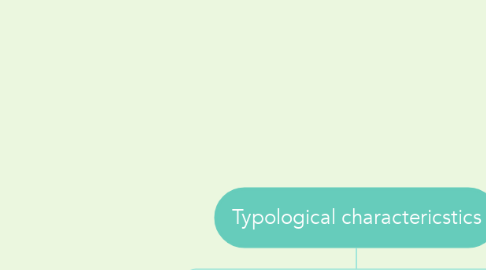
1. The Adverb
1.1. expresses the quality or state of an action, the circumstances in which the action proceeds, or a degree of some other quality
1.1.1. Adverbs in Ukrainian may be formed by means of suffixes, eg: -o (гарно, надійно), -е (добре, зле), -а (дарма, лежма), -и (полюдськи, по-французьки), -ому (по-їхньому), -ему (по-моєму, по-своєму) and by means of prefixes and suffixes (com-bined), eg: no- (no-людськи, по-свинськи), най- (найкраще, най-зручніше), щонай-(щонайбільше); якнай- (якнайшвидше).
1.1.1.1. A characteristic feature of Ukrainian adverbs is their correlation with indirect case forms of prepositional nouns, for example: adverbs correlating with the genitive case forms of nouns and the prepositions без, від/од, до, з/с, за: безвісти, безперестанку, відразу/одразу, догори, додому,
1.1.2. English adverbs are mostly formed with the help of the suffixes -ly (greatly, slowly), -ward/-wards (seaward, eastwards), -ways (sideways), -fold (twofold) and partly with the help of the prefixes -a- (aback, aside; astride) and be- (before, besides)
1.2. In accordance with their lexico-syntactic meaning, adverbs in the contrasted languages fall under the following three main divisions
1.2.1. 1) qualifying adverbs denoting the quality or state of an action
1.2.1.1. badly, fast, slowly, well — погано, добре, швидко, повільно
1.2.2. 2) adverbs expressing the manner in which the action is performed
1.2.2.1. aloud, how, aloof, upside down, by heart, in turn, one by one, al-most, enough, entirely, rather, sufficiently, very — вголос, напа-м'ять, скоса, спросоння
1.2.3. 3) adverbs giving a quantitative characteristics of an ac-tion/quality
1.2.4. The second group:
1.2.4.1. 1) adverbs of time: now, always, then, today, tomorrow, just, so far, sooner or later - зараз, тоді, завжди, сьогодні, взавтра, щойно, рано чи пізно
1.2.4.2. 2) adverbs of frequen-cy/repetition of an action: always, daily, frequently, twice, usually - завжди, щоденно, часто, двічі, звичайно
1.2.4.3. 3) adverbs and ad-verbial phrases of place or direction of an action: here, there, in-side, inwards, outside, somewhere, nowhere, to and fro, etc. тут, там, надворі, десь, ніде, туди й сюди
1.2.4.4. 4) a small group of adverbs in both contrasted languages is presented by those ex-pressing cause and purpose. Eg.: rashly згарячу (Марків партнер палахнув ізгарячу
2. The Numeral
2.1. The syntagmatic properties of numerals are characterised in the contrasted languages by the identical combinability of numerals
2.1.1. a) with nouns (four days, the first step; чотири дні, перший крок)
2.1.2. b) with pronouns (all three, some five or so; всі три, якихось п'ятеро з них)
2.1.3. с) with numerals (two from ten, one of the first, the second of the ten; два від п'яти, один із перших, другий з-поміж п'яти)
2.1.4. d) with adverbs (the two below/ahead, двоє спе-реду)
2.1.5. е) with the infinitive (the first to соте/to read; перша спі-вати, другий відповідати)
2.2. All numerals in the contrasted languages fall into some com-mon and divergent subclasses.
2.2.1. Common are 1) cardinal; 2) ordinal and 3) fractionals (common fractions and decimal fractions)
2.2.1.1. Cardinal numerals in both languages denote number: three, five, ten, twenty-one, etc. три, п'ять, десять, двадцять один.
2.2.1.2. Ordinal numerals denote order of persons or objects and are used in English speech with the definite article: the third, the fifth, the tenth, the twenty-first
2.3. The main allomorphic feature of numerals (like other nominals) find their expression in the existence of morphological/categorial endings pertained to most numerals that are declinable in Ukraini-an. They have number, case and partly gender distinctions
2.4. Apart from the above-given subclasses, the Ukrainian language has two more subclasses of numerals unknown in English.
2.4.1. 1) The indefinite cardinal numerals which express
2.4.1.1. a) common homogeneous objects (декілька/кілька голубів/риб, квіток); кільканадцять книжок (гривень/риб); кількаде-сят/кількасот чоловіків, жінок)
2.4.1.2. b) an indefinite quantity of objects: багато/небагато книжок (цукру, добра, користі
2.4.1.3. 2) Ukrainian has also collective numerals which denote a quantity of objects in their totality (сукупність) or indivisible unity, eg: двоє, троє, семеро, п'ятнадцятеро, тридцятеро (дітей, ві-кон, чоловіків)
2.5. Numerals in English and Ukrainian may be of isomorphic and allomorphic structure.
2.5.1. 1) Simple (one, two, ten, eleven; один, п'ять, десять, десятеро, двійко, мало, багато, etc)
2.5.2. 2) Derivative numerals, pertaining to English only (cf. thirteen, fourteen... nineteen, twenty, thirty, fif-ty... ninety)
2.5.3. 3) Compound numerals in English are all from twen-ty-one (twenty-two, etc.) to ninety-nine. In Ukrainian compound are numerals in -надцять (from одинадцять to дев'ятнадцять), and in tens (from двадцять to дев'яносто), except сто.
2.5.4. 4) Composite in the contrasted languages are numerals consisting of compound/composite + simple numerals or vice versa, eg: one hundred and twenty, twenty-two thousand, five hundred and thir-ty-one; сто два, триста один, дві тисячі п'ятсот тридцять два

